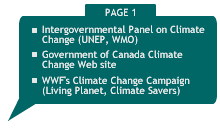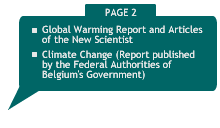|
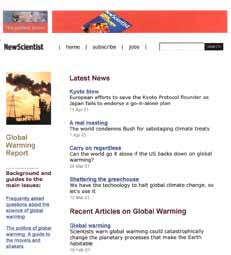
In
the Global Warming section of this New Scientist's
Magasine website, you can find not only many recent (and old) press
articles about Global Warming but also quite a few quite interesting
and complete reports dedicated to the topic.
A rare collection of information.
Here
are some Headlines
Latest News :
Kyoto
blow : European efforts to save the Kyoto Protocol flounder
as Japan fails to endorse a go-it-alone plan (11 Apr 01)
A
real roasting :
The world condemns Bush for sabotaging climate treaty (7 Apr 01)
Carry
on regardless :
Can the world go it alone if the US backs down on global warming
? (24 Mar 01)
Shattering
the greenhouse :
We have the technology to halt global climate change, so let's use
it
(10 Mar 01)

Recent
Articles about Global Warming (some)
:
Global
Warming : Scientists warn global warming could catastrophically
change the planetary processes that make the Earth habitable (19
Feb 01)
Dead
seas : As temperatures rise, the fate of ocean life hangs
in the balance (13 Jan 01)
High
and dry : Don't blame global warming for every flood (9
Dec 00)
Smokescreen
exposed : A new report suggests the Kyoto Protocol on climate
change is unworkable (26 Aug 00)
Gas
from the past : It took a handful of shells from a mountain
under the Pacific to confirm carbon dioxide's central role in the
drama of Earth's changing climate (22 Apr 00)
The
hole story : Every year, about this time, the air above
the Arctic teeters on the brink of an ozone-destroying frenzy. Just
how bad will it get? Gabrielle Walker braved the Swedish winter
to find out (25 Mar 00)
The
heat is on : Global warming is accelerating faster than
climate modellers predicted (4 Mar 00)
Burning
backwards : Could cunning chemistry keep carbon emissions
in check ? (29 Jan 00)

Global
Warming FAQ :
All you ever wanted to know about climate change
What
is the greenhouse effect?
Warmth
from the Sun heats the surface of the Earth, which in turn radiates
energy back out to space. Some of this outgoing radiation, which
is nearly all in the infrared region of the spectrum, is trapped
in the atmosphere by so-called greenhouse gases. For instance, water
vapour strongly absorbs radiation with wavelengths between 4 and
7 micrometres, and carbon dioxide absorbs radiation with wavelengths
between 13 and 19 micrometres.
The
trapped radiation warms the lower part of the Earth's atmosphere,
the troposphere. This warmed air radiates energy - again, largely
in the infrared - in all directions. Some of the radiation works
its way up and out of the atmosphere, but some finds its way back
down to the Earth's surface, keeping it hotter than it would otherwise
be. This is the greenhouse effect.
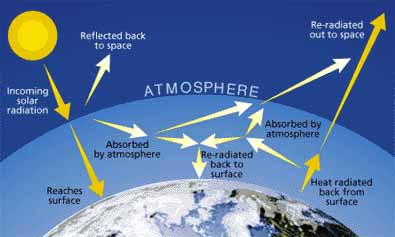 Are
water and carbon dioxide all we have to worry about? Are
water and carbon dioxide all we have to worry about?
No.
Other gases can absorb infrared radiation and contribute to greenhouse
warming. These include methane, ozone, CFCs (chlorofluorocarbons)
and nitrous oxide (released by nitrogen-based fertilisers). Of these,
methane is the most important. Its concentration in the atmosphere
has more than doubled since pre-industrial times. Sources of methane
include the biological activity of bacteria in paddy fields and
the guts of cattle, the release of natural gas from landfills and
commercial oil and gas fields, and vegetation rotting in the absence
of oxygen - for instance, in the depths of man-made reservoirs.
Recent studies suggest this last source could be responsible for
up to a fifth of global methane emissions. Molecule for molecule,
other substances are even more potent greenhouse gases. A single
molecule of either of the two most common CFCs has the same greenhouse
warming effect as 10,000 molecules of CO2.
And
the greenhouse effect is a thoroughly bad thing?
Not
quite. Without it, the planet wouldn't be warm enough to support
life as we know it. The problem is that beneficial natural levels
of greenhouse gases in the atmosphere are being boosted by human
activities, especially the burning of fossil fuels. If nothing is
done to curb emissions of CO2, for example, the amount of CO2 in
the atmosphere will probably be more than double pre-industrial
levels by the end of the 21st century.
How
do we know what these levels were?
The
most informative measurements have come from bubbles of air trapped
in Antarctic ice. These show that for at least the past 400,000
years, CO2 levels in the atmosphere have closely followed the global
temperatures as revealed in ice cores, tree rings and elsewhere.
If
it's all so precise, why is there so much confusion and uncertainty
about global warming? Surely if we know how much CO2 is entering
the atmosphere and how much energy each molecule can trap, we ought
to be able to calculate the overall warming effect?
It's
not that simple. For example there is no easy formula for predicting
what future increases in CO2 levels will do to the average global
temperature. While we can calculate that a doubling of CO2 in the
atmosphere will force roughly 1 °C warming, the planet is more
complex than that. It could respond by magnifying the effect, but
it could also conceivably damp down the warming. These feedbacks
involve essential planetary processes, such as the formation of
ice, clouds, the circulation of the oceans and biological activity.
What
effects are the main feedbacks likely to have?
One
of the easiest effects to estimate is the "ice-albedo"
feedback. As the world warms, ice caps will melt. As this happens,
water or land will replace parts of the Earth's surface that were
once covered with ice. Ice is very efficient at reflecting solar
radiation into space, whereas water and land absorb far more. So
the Earth's surface will trap more heat, increasing warming - a
positive feedback. Less clear-cut is the impact of the extra water
vapour likely to enter the atmosphere because of higher evaporation
rates. This added water vapour itself contributes to the greenhouse
effect, another positive feedback. But it may also increase cloud
cover. The dominant effect of some low-altitude clouds is to shroud
and cool the Earth - a negative feedback - but other clouds, such
as cirrus, may trap heat at low levels, giving another positive
feedback.
Disputes
about how water vapour and clouds will influence global warming
are at the heart of many of the disputes between mainstream scientists
and the handful of greenhouse sceptics. Overall, the majority view
is that positive feedbacks could amplify the warming effect by perhaps
2.5 times. But some sceptics believe the feedback effect could be
neutral or even predominantly negative.
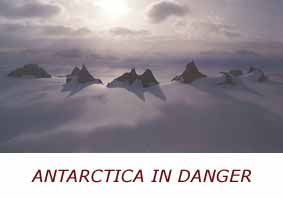 Why
do sceptical scientists think that? Why
do sceptical scientists think that?
One
reason is that something strange has been happening to warming trends
in the past couple of decades. While ground-level temperatures around
the world have gone up, the warming has failed to penetrate the
atmosphere. The atmosphere has actually been cooling in some large
areas three kilometres above the Earth. According to computerised
climate models, the warming should spread right through the troposphere,
the bottom ten kilometres or so of the atmosphere. Sceptics argue
that if the models are wrong about how surface warming influences
temperatures in the troposphere, they are also likely to be wrong
about the movement of water vapour between the surface and the upper
troposphere. That in turn may mean they are wrong about water-vapour
feedback - one of the vital mechanisms behind global warming.
So
does this mean there are some scientists who don't believe in the
greenhouse effect or global warming?
No,
this is a myth. All scientists believe in the greenhouse effect.
Without it the planet would be largely frozen. And all scientists
accept that if humans put more greenhouse gases in the atmosphere
it will tend to warm the planet. The only disagreement is over precisely
how much warming will be amplified by feedbacks. And there is a
growing consensus that the average global warming of 0.6 °C
seen in the past century - and particularly the pronounced warming
of the past two decades - is largely a consequence of the greenhouse
effect.
|
